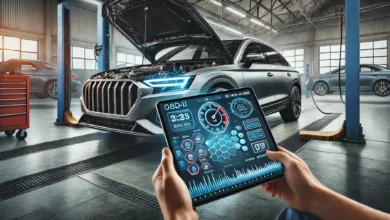The Impact of AR and VR on E-Commerce and Consumer Experience
The world of e-commerce has evolved rapidly over the past decade, driven by advancements in technology and shifting consumer behaviors. As more consumers turn to online shopping, businesses have been compelled to find innovative ways to bridge the gap between the convenience of digital shopping and the tactile experience of brick-and-mortar stores. This is where Augmented Reality (AR) and Virtual Reality (VR) come into play, revolutionizing the way people shop online. By creating immersive, interactive shopping experiences, AR and VR are not only transforming e-commerce but also reshaping the entire consumer journey.
Understanding AR and VR Technology
Before diving into their impact on e-commerce, it’s important to understand what AR and VR are.
AR (Augmented Reality) overlays digital information onto the real world, enhancing what the user sees. Imagine pointing your smartphone at an empty room and visualizing how furniture would look in that space. That’s AR at work — it blends the physical world with computer-generated elements.
VR (Virtual Reality), on the other hand, immerses users in a completely virtual environment, replacing the real world with a simulated one. When you put on a VR headset, you are transported into a 3D world where you can interact with digital objects in real time. In an e-commerce context, VR can create virtual stores or environments that consumers can explore from the comfort of their own home.
These technologies provide new and dynamic ways for consumers to engage with products before making a purchase, offering the kind of hands-on experience that was once exclusive to in-store shopping.
Evolution of Technology in E-Commerce
E-commerce has come a long way from simple online catalogs and one-click purchases. In the early days, it was enough to have a functional website where customers could place orders. But as consumer expectations evolved, so did the technology behind online shopping. Over time, interactive tools such as chatbots, personalized recommendations, and advanced search algorithms became commonplace.
Today, AR and VR represent the next wave of this evolution. By offering interactive, immersive shopping experiences, they take consumer engagement to new heights, effectively merging the digital and physical shopping worlds.
How AR Enhances Consumer Experience in E-Commerce
One of the most significant ways AR enhances online shopping is through virtual try-ons. Whether it’s clothing, accessories, or makeup, AR allows consumers to see how products will look on them without having to physically wear them. This technology eliminates the guesswork from online shopping and helps reduce the likelihood of buying items that don’t fit or suit the customer’s preferences.
AR also shines when it comes to interactive product visualizations. Imagine shopping for furniture online and being able to place a 3D model of a chair or table in your living room using your phone. AR lets consumers visualize products in their real environment, helping them make more informed purchasing decisions. This is particularly useful for home decor, where size, color, and style need to be perfectly matched to the buyer’s existing space.
Another exciting application of AR in e-commerce is the use of augmented shopping assistants. These digital helpers can guide consumers through their shopping journey, offering personalized product suggestions, real-time customization options, and even tutorials on how to use certain items.
The Role of VR in Revolutionizing Online Shopping
While AR enhances real-world interactions with products, VR takes consumers into entirely new environments. Imagine stepping into a virtual storefront, where you can browse through items as if you were walking through a physical store. You can pick up products, examine them closely, and even watch VR-based product demos that show you exactly how a product works.
For more complex products, VR offers 360-degree views and immersive tours. Whether you’re buying a car, exploring real estate options, or considering large appliances, VR allows you to experience products in an incredibly lifelike way. This not only enhances the shopping experience but also builds confidence in the consumer’s purchasing decisions.
By replicating the in-store experience virtually, VR allows online shoppers to “walk through” a store without leaving their home. This is particularly impactful for customers who enjoy the physical act of shopping but appreciate the convenience of online retail.
How AR and VR Bridge the Gap Between Physical and Online Shopping
One of the key challenges of e-commerce has always been the inability to physically interact with products before buying them. AR and VR help bridge this gap, providing a more tactile online shopping experience. By allowing consumers to virtually try on or visualize products in their own environment, these technologies replicate some of the benefits of in-store shopping, such as touch, feel, and scale.
This ability to engage more deeply with products also helps reduce return rates. When consumers can see how a couch will look in their living room or how a jacket will fit on their body, they’re far less likely to make purchasing mistakes. This leads to fewer returns and a more satisfied customer base.
The Influence on Consumer Decision-Making
AR and VR have a profound impact on consumer decision-making. Traditional e-commerce relies heavily on product images and descriptions, which can sometimes fall short in conveying the true nature of an item. But with AR and VR, consumers are able to engage visually and interactively, which enhances their confidence in the products they’re considering.
For instance, with AR-enabled try-ons, consumers can experiment with different looks or styles before committing to a purchase. VR can offer virtual tours of products or environments, allowing potential buyers to fully immerse themselves and gain a comprehensive understanding of what they’re purchasing. This immersive engagement translates into higher conversion rates and improved customer satisfaction.
Personalization Through AR and VR
One of the most powerful aspects of AR and VR in e-commerce is their ability to offer personalized shopping experiences. With AR, customers can customize products in real-time, whether that’s changing the color of a piece of furniture or adjusting the size of a fashion item. VR takes personalization a step further by allowing users to explore personalized virtual environments, tailored to their preferences and interests.
This level of personalization fosters a deeper connection between the consumer and the brand, ultimately leading to better customer retention. When consumers feel like a shopping experience has been designed specifically for them, they are more likely to return.
The Role of AR and VR in Consumer Engagement and Retention
It’s no secret that engagement is a critical factor in e-commerce success. The longer a customer spends on a platform, the more likely they are to make a purchase. AR and VR significantly increase dwell time by providing interactive and entertaining experiences. Whether it’s a fun AR filter for trying on sunglasses or a VR tour of a luxury home, these technologies keep consumers engaged and curious.
Beyond just keeping customers on a platform longer, AR and VR also enhance the overall fun factor of shopping. When shopping becomes an enjoyable experience rather than a chore, consumers are more likely to return. This emotional connection, created through immersive experiences, is key to building long-term customer relationships.
Transforming Marketing Strategies with AR and VR
AR and VR are not just transforming the shopping experience; they’re also reshaping marketing strategies. With AR-based interactive advertisements, brands can create ads that consumers can engage with directly, offering a new level of interactivity that traditional ads simply can’t provide.
VR, on the other hand, is being used for virtual product launches and events. Imagine attending a product unveiling in a virtual world, where you can interact with other attendees, explore the product, and even test it out in a simulated environment. This type of immersive marketing is far more engaging than standard online ads or emails, making a lasting impression on potential buyers.
Challenges and Limitations
While the potential of AR and VR in e-commerce is vast, there are still challenges that need to be addressed. One of the biggest hurdles is the cost of developing these technologies, particularly for smaller businesses. Creating high-quality AR and VR experiences requires significant investment in both time and resources, which can be prohibitive for many.
Additionally, there are accessibility concerns. While AR is more accessible through smartphones and tablets, VR typically requires specialized headsets, which not all consumers have. This limits the widespread adoption of VR-based e-commerce experiences, at least for the time being.
Future Trends in AR and VR for E-Commerce
Despite these challenges, the future of AR and VR in e-commerce is incredibly promising. As technology continues to advance, we can expect to see even more sophisticated AR and VR experiences. For example, wearable devices are becoming more integrated with these technologies, offering seamless, hands-free interaction with virtual environments.
Moreover, the concept of the metaverse is starting to take shape, creating entirely new virtual worlds where consumers can shop, socialize, and explore. As the metaverse grows, AR and VR will play a crucial role in creating these immersive digital environments, further blurring the line between online and offline experiences.
The Potential for AR and VR in Global E-Commerce Markets
As AR and VR technologies become more affordable and accessible, their impact will expand to global e-commerce markets. In regions where physical stores may be less prevalent, AR and VR offer consumers the opportunity to experience products in ways they never could before. Additionally, these technologies make cross-border shopping more engaging, as consumers can explore products from foreign markets in immersive ways.
By bringing immersive shopping experiences to new markets, AR and VR have the potential to reshape global e-commerce and create more inclusive shopping environments for all.
The Ethical and Privacy Considerations in AR/VR E-Commerce
As with any technology, the widespread use of AR and VR in e-commerce raises ethical and privacy concerns. In immersive environments, businesses have access to a wealth of data about consumer behavior, preferences, and even physical movements. It’s essential that companies handle this data responsibly, ensuring that consumer privacy is protected and that the use of data is transparent and ethical.
Furthermore, there’s the issue of ensuring that AR and VR experiences are safe and accessible for all users. This means addressing potential health risks associated with prolonged use of VR headsets and ensuring that all consumers, regardless of their physical abilities, can engage with these technologies in a meaningful way.
Conclusion
AR and VR are undoubtedly shaping the future of e-commerce, offering consumers a more immersive, interactive, and personalized shopping experience. By bridging the gap between the online and offline worlds, these technologies are making online shopping more engaging and tactile, ultimately transforming the way consumers shop. As AR and VR continue to evolve, their impact on e-commerce will only grow, offering exciting possibilities for both businesses and consumers alike.
The integration of AR and VR into e-commerce represents a paradigm shift that will continue to revolutionize the way we interact with products and brands. While there are still challenges to overcome, the potential benefits of these technologies far outweigh the hurdles. In the future, it’s likely that AR and VR will become integral components of the online shopping experience, creating a more engaging, personalized, and enjoyable consumer journey.


